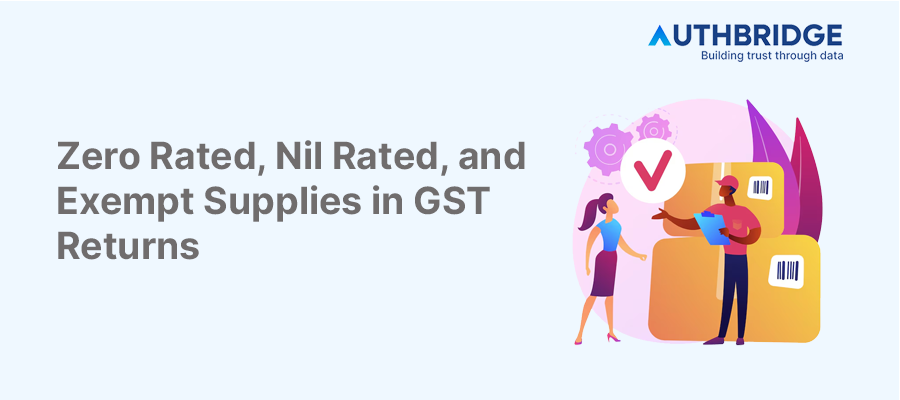Understanding Zero Rated, Nil Rated, And Exempt Supplies In GST Returns

1. Overview of GST Supply Categories
Definition and Importance
In the Goods and Services Tax (GST) regime, supplies are categorized based on their tax implications to streamline tax administration and compliance. Understanding these categories is crucial for businesses to correctly charge GST, claim Input Tax Credit (ITC), and comply with GST regulations.
Classification of Supplies
GST classifies supplies into several categories, including Nil Rated, Exempt, Zero Rated, and Non-GST supplies. Each category has distinct tax implications and eligibility criteria for ITC, affecting how businesses report them in GST returns.
2. Nil Rated Supplies
Definition and Characteristics
Nil rated supplies are goods or services on which GST is applied at a rate of 0%. While GST is levied on these supplies, no tax is collected from the consumer. Businesses dealing in nil rated supplies can neither charge GST on their sales nor claim Input Tax Credit (ITC) for taxes paid on inputs used in producing these goods or services.
Examples and Reporting in GST Returns
Common examples of nil rated supplies include essential commodities like grains, salt, and jaggery. When reporting nil rated supplies in GST returns, businesses must include them in their GSTR-1 under the appropriate section but without any tax liability. This ensures transparency in reporting without contributing to the business's GST payable.
3. Exempt Supplies
Definition and Characteristics
Exempt supplies refer to goods and services that are exempt from GST. Businesses making exempt supplies do not charge GST on their sales and cannot claim ITC on inputs related to these supplies. The exemption aims to make essential goods and services more affordable for the general public.
Examples and Reporting in GST Returns
Examples of exempt supplies include bread, fresh fruits, fresh milk, and curd. In GST returns, exempt supplies must be reported separately in GSTR-1 to ensure compliance and proper accounting, even though they do not contribute to GST liability.
4. Zero Rated Supplies
Definition and Characteristics
Zero rated supplies are exports or supplies to Special Economic Zones (SEZs) taxed at 0% GST rate. Unlike nil rated and exempt supplies, businesses dealing in zero rated supplies can claim a refund of ITC on inputs used to make these supplies, promoting exports and SEZ-related activities.
Examples and Reporting in GST Returns
Zero rated supplies include overseas supplies and supplies to SEZs or SEZ developers. These must be reported in GSTR-1 with relevant details to claim ITC refunds. The refund process involves filing an application along with necessary documentation to substantiate the zero rated supply transactions.
Refund Process for Zero Rated Supplies
The GST refund process for zero rated supplies is facilitated through the filing of relevant forms on the GST portal, supported by documents like shipping bills and tax invoices. This process ensures that businesses can recover the GST paid on inputs, enhancing their competitiveness in international markets.
5. Non-GST Supplies
Definition and Characteristics
Non-GST supplies are transactions not covered under the GST regime but may be subject to other taxes. These supplies do not form part of the GST taxable turnover and are not eligible for ITC.
Examples and Reporting in GST Returns
Examples include petrol and alcohol for human consumption. While reporting GST returns, businesses must mention non-GST supplies separately to maintain clear records and comply with GST regulations, despite these supplies not affecting GST liability.
6. Impact on Input Tax Credit (ITC)
ITC Eligibility for Different Supply Categories
- Nil Rated Supplies: No ITC can be claimed.
- Exempt Supplies: No ITC can be claimed.
- Zero Rated Supplies: ITC can be claimed and refunded.
- Non-GST Supplies: Not applicable for ITC.
7. Best Practices for Reporting in GST Returns
- Accurate Classification: Ensure supplies are correctly classified to avoid compliance issues.
- Timely Reporting: Report all transactions, including nil rated, exempt, zero rated, and non-GST supplies, in the appropriate sections of GST returns within the prescribed timelines.
- Documentation: Maintain thorough records and documentation to support the classification and reporting of supplies, facilitating smooth ITC claims and compliance checks.
Understanding the nuances of nil rated, exempt, zero rated, and non-GST supplies is essential for accurate GST compliance and optimising tax benefits. Businesses should adopt best practices in classification and reporting to ensure smooth operations under the GST framework.
Category

Abhinandan Banerjee
(Associate Manager - Marketing)
Abhinandan is a dynamic Product and Content Marketer, boasting over seven years of experience in crafting impactful marketing strategies across diverse environments. Known for his strategic insights, he propels digital growth and boosts brand visibility by transforming complex ideas into compelling content that inspires action.



